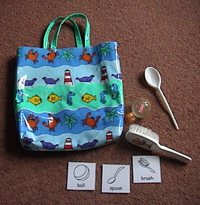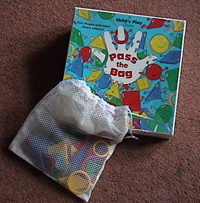Feely-bag games
Ideas to aid recognition by touch
Lander, A. (2006) Feely-bag games. Down Syndrome News and Update, 6(1), 14-15. doi:10.3104/practice.375
Reading the evaluation of using the Numicon system to teach number skills to children with Down syndrome in the November 2005 issue reminded me of my experiences using Numicon with a boy during Years 4 and 5 in primary school. In particular the authors mention children who do not like the feely-bag activities.
When we reached the feely-bag work, Will refused completely to attempt the activity. This was not because he was averse to the bag itself or to putting his hand in, as he had been taking out shapes and pegs quite happily over the previous weeks. It was suggested to me that he came to this activity with a long history of failing. He had been using the Numicon materials without much progress in previous terms.
It is surprisingly difficult to feel the Numicon shapes. I find with the larger shapes I was putting my fingers in the holes and counting, but what if your counting is unreliable? What if you haven't really grasped and internalised the meaning of 'odd' and 'even'?
Will's total refusal to try this activity reminded of the many times I have prepared a 'game' in order to work with my daughter (who also has Down syndrome), only to find the new concept too difficult for her to take in. In these situations I had tried to take out the education bit and just find a way for her to learn the idea of the game.
I set about finding a way to make the feely-bag game more accessible and above all, fun. I used a small brightly coloured PVC bag and searched about the house for objects that had very distinctive tactile shapes. The first objects I came up with were a soft-bristled baby brush, a dessert spoon and a small bouncy ball. I tested them out on my family to check how easy they were to identify by feel. I made some little cards with the words and symbols on them using Widget's software Writing with Symbols 2000.

Our first step was to look at everything and match the cards to the objects. Then I took the three objects, put them in the bag and shook them up. I left the cards on the table so there was a visual reminder of what was in the bag. I asked Will to pick out an object and tell me what it was. He took out the ball. After a short time playing with it, he matched it with the card and took out another object, matched that, and so on. We may have played the game once more that day, then everything was put away for the next day.
Over the next weeks we gradually added more objects, initially ones that were easy to pick out by feel or which were amusing and fun to play with. The local party shop was a great source of funny items: clockwork fish, sticky frogs, spinning tops etc. I made cards for each item and Will chose which things went into the bag. Usually he chose things he particularly liked playing with. We got up to six objects. We played the game lots of different ways. Sometimes we would put the chosen cards in a pile and take turns to take the top card and find the object, sometimes I would fan them out and Will would choose one. We would take turns choosing objects to go in the bag. Occasionally we would ask each other "Can you find the…?" Sometimes I would feel an object and describe it: "I've got something which has four legs and a very long neck" and Will would yell out "Giraffe". You can use this very effectively as a language game too, encouraging the child to describe the object for you to guess. Also for memory practice when you reach the last object: "Can you remember what else we put in the bag?"

Some weeks later Will had become very confident with this game and I introduced the first Numicon shape, the yellow three, which has both a very distinctive shape to feel and was also large enough not to drop to the bottom of the bag immediately. When it was just one of many objects, it became part of the game and was accepted without anxiety. Very gradually we added more Numicon, the one and the two, also with no problem. The class began doing some work on shapes, so I found a square, circle and triangle. In this way we were doing the same topic as everyone else but at our own level.
Sadly, at this point I left the school but I am sure that had we continued working in this very relaxed way more and more Numicon shapes could have been added to the bag without any upset. I know that at home my daughter loves this game and has become very reliable at identifying items.
For children who have an aversion to putting their hands in the bag to play this game, you could start with an empty bag and get them to choose what objects to put in. Or use a clear fruit bag from the supermarket, then move on to a bag with one see-through side. (There is a useful bag in the commercial game "Pass the Bag".)

I think probably the most important thing to remember is to start with objects which feel distinctly different and would be hard to confuse with anything else. For example, a spoon and a fork have too many similarities until one is quite experienced at the game; starting with Numicon shapes could be too off-putting. I think it is also important to have the prompt cards visible. It seems to me essential to make it a success from the beginning. None of these aids are 'cheating' but rather build confidence so that the game becomes a pleasure not a chore.
Numeracy resources
NEW: Teaching number skills to children with Down syndrome using the Numicon Foundation Kit (2006). Joanna Nye. Down Syndrome Education International.
Number skills for individuals with Down syndrome - An overview (2001). Gillian Bird and Sue Buckley. Down Syndrome Education International. [Open Access Full Text ]
Number skills for infants with Down syndrome (0-5 years) (2001). Gillian Bird. The Down Syndrome Educational Trust. [Read Online ]
Number skills for children with Down syndrome (5-11 years) (2001). Gillian Bird and Sue Buckley. The Down Syndrome Educational Trust. [Open Access Full Text ]
Number skills for teenagers with Down syndrome (11-16 years) (2002). Gillian Bird and Sue Buckley. Down Syndrome Education International. [Open Access Full Text ]
Teaching math to people with Down syndrome and other hands-on learners (2004). DeAnna Horstmeier. Woodbine House.
Numicon number teaching materials.
123-CD. Software by Sherston.
NumberShark3. Software by White Space Limited.
All the resources listed above are available from Down Syndrome Education International. Please visit the downsed online shop at https://store.down-syndrome.org/
Writing with Symbols 2000. Software by Widgit. https://www.widgit.com/
Pass the Bag. Game from Childs Play at www.childs-play.com

